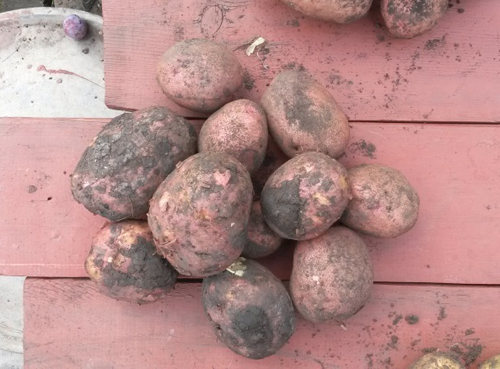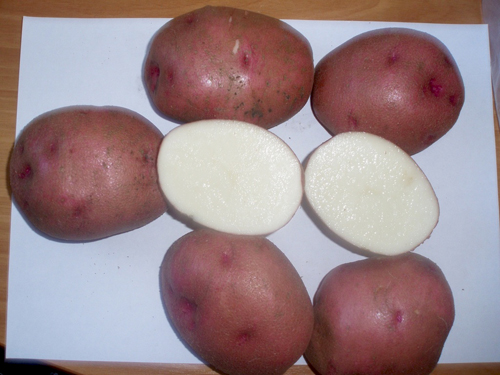Potato variety Lyubava
Lyubava is an early maturing domestic potato variety (Solanum tuberosum) for table use. Bred by the joint efforts of specialists of the FSBSI "All-Russian Research Institute of Potato Farming. A.G. Lorkh "and the Kemerovo branch of the Federal State Budgetary Scientific Institution" Siberian Federal Scientific Center of Agrobiotechnology of the Russian Academy of Sciences ". In 2003, it was included in the state register of plants of the Russian Federation in four regions: the Ural, West Siberian, East Siberian and Far Eastern regions. Suitable for cultivation both for personal consumption and for commercial production. It tolerates transportation well.

The time from the emergence of full shoots to harvest is 55-70 days, but the first digging can be carried out already on the 45th day.
The plant is not tall, of an intermediate type. The stem is semi-erect. The leaves are small, open, slightly wavy at the edges, dark green. The flowers are medium-sized, red-violet in color. The flowering intensity is medium.
Lyubava's tubers are large, weighing 100-210 grams, oval-rounded, regular in shape, on one plant their number can reach 20 pieces. The peel is dense, has a reticular structure, is colored red, rough to the touch. The pulp is white. The eyes are small, their depth is average. The marketability of tubers is impressive - about 98%. The starch content in them fluctuates at the level of 11.2-16.9%, which exceeds the indicators of Aksamit and Beloyarsky early potatoes by 0.9-1.9%.
The yield is at a high level - 288-400 c / ha, 51-108 c / ha more than the standards of the varieties Beloyarsky Early and Pushkinets. At the first digging, on the 45th day after full germination, it is possible to collect 145-200 c / ha, which is 25-94 c / ha higher than the indicators of Beloyarsky Early and Pushkinets, and during the second digging, on the 55th day, - 203 −272 c / ha, 59-70 c / ha more than Alena and Pushkinets. The maximum yield was observed in the Tomsk region - 524 c / ha, 134 c / ha higher than the Aksamit standard. The keeping quality of tubers is excellent - 98%. During storage, they do not germinate for a long time.
Good taste, friable pulp, does not darken during heat treatment. Lyubava is especially recommended for making mashed potatoes, French fries and chips. But, in general, in cooking, it is universal, so it will become an excellent component of any dish.

The variety is very picky about the composition of the soil, prefers fertile soils. However, it responds well to the introduction of organic and mineral fertilizers. Also, plants respond well to watering, but at the same time they can tolerate drought quite persistently. According to some reports, the resistance to waterlogging of the soil is also high, but still you should not get too carried away with watering. Many gardeners plant several times per season and recommend digging up potatoes 45 days after germination in order to get more harvest. And this approach is very justified, because the tubers have excellent keeping quality and do not lose their consumer qualities during long-term storage. Of course, with this growing regime, it is worth taking care of sufficient fertilization in the soil, and also not forgetting about the crop rotation. The variety is popularly considered very reliable; when choosing it, you obviously will not be the loser.
In general, Lyubava is very unpretentious and does not require special care. Of course, standard farming practices should not be neglected. Below are simple tips to help you grow a good crop.
- The place for potatoes is set aside sunny. It is important to observe crop rotation, so you should not plant tubers on an area where other nightshade crops have grown before.
- Planting should be done around early to mid-May, when the soil warms up to + 8 ° C and the danger of recurrent frosts has passed.
- The depth of planting tubers in the ground is about 8-10 cm, the planting pattern is 35 × 75 cm.
- During the growing season, fertilizing should be done as needed. A month after planting, nitrogen fertilizers can be added to the soil, potassium-phosphorus fertilizers during the flowering phase, and complex mineral fertilizers 2 weeks after its completion.
- Do not forget about loosening the soil and hilling, weeding, watering, as well as treating diseases and pests.

This potato is highly resistant to cancer and viruses. According to the All-Russian Research Institute of Phytopathology, the tops are prone to damage by late blight, while tubers are much less susceptible to it. Plants are susceptible to golden potato cyst nematode and common scab. There is information that the Colorado potato beetle bypasses this variety.
Many gardeners speak very well of Lyubava. She is especially praised for the amicable formation of tubers, excellent taste, undemanding care and, of course, excellent yield. The high yield of marketable tubers, approximately the same in size, deserves attention. Early ripening and good keeping quality complete this wide list of advantages. The main disadvantage is considered susceptibility to certain diseases, however, it is quite simple to cope with this with the help of preventive treatments.
Resistance to degeneration is also noted, as a result of which the seed does not need to be frequently renewed. Unfortunately, good planting material is currently quite difficult to find, since more modern varieties have gradually ousted Lyubava from the wide market. However, it is still in high demand among amateur potato growers. It is safe to say that this is one of the most reliable, time-tested varieties of Russian selection.








